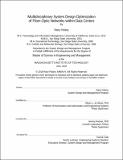Multidisciplinary system design optimization of fiber-optic networks within data centers
Author(s)
Polany, Rany
DownloadFull printable version (8.339Mb)
Other Contributors
Massachusetts Institute of Technology. Engineering Systems Division.
Advisor
Oliver L. de Weck and Jeremy Kepner.
Terms of use
Metadata
Show full item recordAbstract
The growth of the Internet and the vast amount of cloud-based data have created a need to develop data centers that can respond to market dynamics. The role of a data center designer, whom is responsible for scoping, building, and managing the infrastructure design is becoming increasingly complex. This work presents a new analytical systems approach to modeling fiber-optic network design within data centers. Multidisciplinary system design optimization (MSDO) is utilized to integrate seven disciplines into a unified software framework for modeling 10G, 40G, and 100G multi-mode fiber-optics networks: 1) market and industry analysis, 2) fiber-optic technology, 3) data center infrastructure, 4) systems analysis, 5) multi-objective optimization using genetic algorithms, 6) parallel computing, and 7) simulation research using MATLAB and OptiSystem. The framework is applied to four theoretical data center case studies to simultaneously evaluate the Pareto optimal trade-offs of (a) minimizing life-cycle costs, (b) maximizing user capacity, and (c) maximizing optical transmission quality (Q-factor). The results demonstrate that data center life-cycle costs are most sensitive to power costs, 10G OM4 multi-mode optical fiber is Pareto optimal for long reach and low user capacity needs, and 100G OM4 multi-mode optical fiber is Pareto optimal for short reach and high user capacity needs.
Description
Thesis: S.M. in Engineering and Management, Massachusetts Institute of Technology, School of Engineering, System Design and Management Program, Engineering and Management Program, 2016. This electronic version was submitted by the student author. The certified thesis is available in the Institute Archives and Special Collections. Cataloged from student-submitted PDF version of thesis. Includes bibliographical references (pages 136-142).
Date issued
2016Department
Massachusetts Institute of Technology. Engineering and Management Program; System Design and Management Program.Publisher
Massachusetts Institute of Technology
Keywords
Engineering and Management Program., System Design and Management Program., Engineering Systems Division.